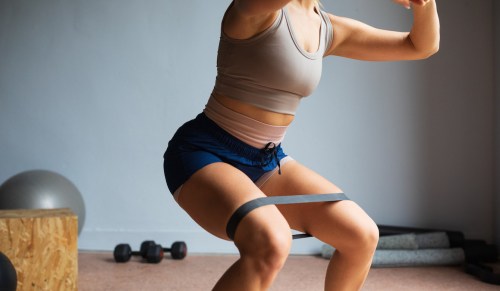We all know that core strength is important, but knowing exactly how to strengthen your core can be confusing, especially for beginners. Should you do crunches? Planks? What about social media’s favorite new buzzword: anti-rotation exercises?
Experts in This Article
Although anti-rotation core exercises have been used by athletes for years, the term has become trendier recently—particularly among “fitfluencers” promising solutions to your back pain. Yet most people still aren’t sure what exactly “anti-rotation exercises” actually are.
Well, just like it sounds, an anti-rotation exercise challenges your trunk to resist rotation. “Anti-rotation exercises are core and shoulder exercises that require you to resist rotational forces while maintaining a specific position—either standing, sitting, or laying on your back,” says Luke Greenwell, DPT, a physical therapist and certified strength and conditioning specialist at RecoverRx Physical Therapy. “The resistance can come from cable machines, resistance bands, or free weights.”
Dr. Greenwell says that because anti-rotation exercises require the trunk to resist rotation, they are excellent for isolating four main areas of the body:
- 1.The stabilizer muscles of the shoulders: deltoids, pectoralis major, rhomboids, trapezius, and rotator cuff muscles.
- 2.The primary rotational core muscles: the internal and external obliques.
- 3.The deep core muscles: transverse abdominus in the front and the multifidus and erector spinae in the back.
- 4.The hip stabilizing muscles: the gluteal muscles, hip abductors, and hip adductors.
How can anti-rotation exercises ease back pain?
Because anti-rotation exercises strengthen the deep core muscles, they’re one of the most effective ways to protect your spine—and avoid back pain.
“The spine is a very mobile structure, moving in multiple planes of movement. Therefore, it needs both passive and active stabilizers to protect it from injury,” explains Dr. Greenwell. “In many instances, we are required to lift or resist rotational forces throughout our day, and because of that, need to build resilience to reduce our risk for injury.”
Dr. Greenwell says anti-rotation exercises are so effective compared to other core exercises because they require you to engage your core fully while stabilizing against multiple directional forces. In contrast, something like a crunch or sit-up only actively contracts one set of muscles in one plane of motion.
“By strengthening our shoulder, core, and hip muscles, we’re able to increase the load we’re able to take through the spine,” says Dr. Greenwell. “The muscles in the shoulder, core, and hips are all connected via fascial planes that help create stability in the spine.”
Three anti-rotation exercises to try
Try incorporating anti-rotation exercises into your routine a couple times a week to begin and gradually increase to three or four times a week. “I see the most success implementing these exercises either in the middle or at the end of your workout when you are somewhat fatigued because this is when your body typically is at a higher risk of injury and needs to be strengthened during this time,” Dr. Greenwell says.
He suggests picking one anti-rotation exercise in standing and one in sitting or on your back. Try to keep it as functional as possible—meaning it should mimic everyday movements. Here are three moves he recommends:
1. The Pallof press
This anti-rotation exercise works your core and shoulders.
- Attach a resistance band to a pole or stationary object or use a cable exercise machine. You can perform the exercise kneeling or standing, but the band should be chest height. You should be far enough away from the anchor point that there’s tension on the band.
- Hold the band in towards your chest.
- Bracing your core and squeezing your glutes, straighten your arms by pushing them out away from your chest against the tension of the band.
- Hold the extended position for a full breath and then slowly return your arms to your chest.
- Perform 12 to 15 reps. Rest one minute. Do three sets.
2. Anti-rotation dead bug
“This is slightly more challenging than the Pallof press since your feet are not fixed on the ground,” says Dr. Greenwell.
- Lie on your back in the dead bug position with your knees and hips bent at 90 degrees and hands at your chest holding the resistance band or cable column handle. You should feel tension in the band as you did with the Pallof Press.
- Doing the same pressing motion, press the handle of the band or cable straight up towards the ceiling, without letting the band pull your arms or body to the side.
- Perform 12 to 15 reps. Rest one minute. Do three sets.
3. Lunge with anti-rotation hold
- While holding onto a cable or resistance band with the anchor at your side, press the band away from your body and perform a lunge while not letting the band rotate your torso towards the anchor point.
- Continue alternating lunges while keeping your core activated and trunk as stable as possible.
- Perform 12 reps per side (24 lunges total). Rest one minute. Do three sets.
Sign Up for Our Daily Newsletter
Get all the latest in wellness, trends, food, fitness, beauty, and more delivered right to your inbox.
Got it, you've been added to our email list.











